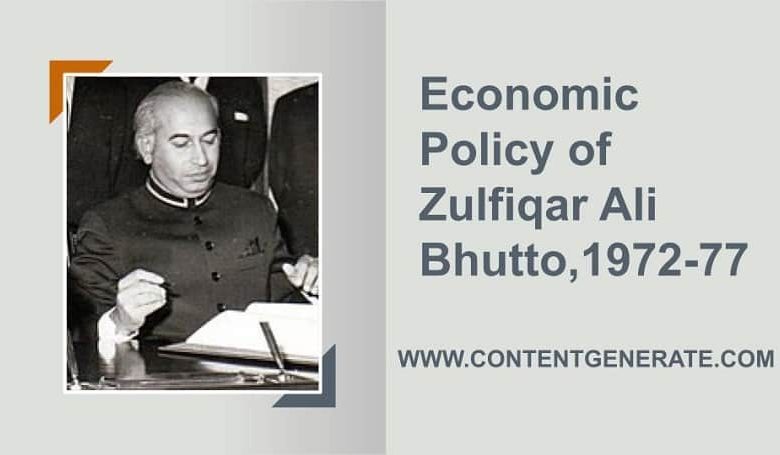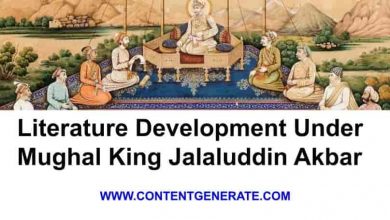Zulfiqar Ali Bhutto’s Economic Policy – Main Features and Impact

Contents
This post discusses Zulfiqar Ali Bhutto’s Economic Policy introduced in Pakistan during his tenure from 1972 to 1977.
Main features of Bhutto’s Economic Policy
The economic policy of Zulfiqar Ali Bhutto was characterized by two important reforms of the nationalization and land reforms as discussed below.
Nationalization of institutions
Before discussing the nationalization that Bhutto introduced, it is important for students to get abreast with the concept of ‘nationalization’.
So what does the term nationalization refer to?
The term nationalization refers to placing private sector institutions e.g. industries, hospitals, insurance companies, banks, etc. under governmental control. In other words, it is a process in which private ownership of assets is taken over by public ownership.
Why did Bhutto introduce the policy of nationalization in Pakistan?
Bhutto regime adopted the policy of nationalization with an aim to:
- take control of industrial production and promote industrialization through proper utilization of funds;
- enhance the living standard and working conditions of the workers, including the provision of cheap housing for public sector employees;
- Provide the workers with the right to form their unions to prevent anti-worker policy or measures;
- end the economic disparity and inequality that had enabled a handful of elite people to own a lion’s share of industrial wealth. According to different accounts, there were twenty industrial houses in the country that owned 65% of Pakistan’s large-scale industry. This small yet powerful elite class influenced the successive governments as they funded other reforms.
- Last but not the least, Z. A. Bhutto wanted to raise the popularity of his political party among the urban people who formed a major part of his political support.
What were the institutions that Bhutto nationalized?
Zulfiqar Ali Bhutto brought almost all major industries, schools, banks, insurance companies under government control.
The nationalized industries included all major metal (iron, steel) industries, heavy engineering, and electricals, petrochemicals, cement, etc. In addition, he nationalized the cotton, rice, vegetable oil, and sugar industries. Similarly, he nationalized major banks, insurance companies, and schools throughout the country.
In all, there were 70 major industrial units that the Bhutto brought under public control. The Federal Ministry of Production coordinated and administered the nationalized industries throughout the county.
What was the impact of nationalization?
The nationalization as part of Bhutto’s economic policy had both positive and negative impacts on the economy of Pakistan.
The reforms were put into effect without a proper plan and prior preparation. As a result, the federal ministry of production had to face difficulty to coordinate the nationalization process throughout the country. The process was very slow and at times stopped because of the lack of bureaucratic readiness and expertise.
Favorable Impact of nationalization?
By the end of the 1960s and in the wake of the 1971 breakup, Pakistan witnessed a spike in the inflation rate which was more than 10%. Bhutto’s nationalization policy however was successful in bringing inflation to 6% in 1976.
The reforms were introduced at a time when the world was facing a global recession. Companies all over the world faced declining demand for their goods due to the reduced purchasing power of people. Consequently, major companies had to face closures as they could not afford to pay their employees and operate at a loss.
In such a fragile economic situation, the private sector enterprises in Pakistan also would have closed but the nationalized industries in the country continued to operate. As a result of the persistent operation of the industries, the economic growth of Pakistan also began to improve.
Land Reforms
The term land reforms refer to changes brought into the laws with reference to land holding, tenancy, etc. Popular land reforms are characterized by changes in laws, regulations regarding land ownership. That is, who will have how much land for the cultivation of crops.
The term ‘land reforms’ also refers to the transfer of ownership from a powerful to less powerful. The government usually pays a reasonable compensation to the landowners from whom it takes the land.
The land reforms as part of Bhutto’s economic policy
Bhutto’s reforms were an attempt to transfer land ownership from a few landlords possessing extensive land holdings to the landless peasants, tenants, etc.
Bhutto’s land reforms were as follows:
- A person would own a maximum of 250 acres of irrigated and 500 acres of un-irrigated land.
- The government would take over the extra land and sell it to the smaller peasants to make better profits.
- Similarly, the people without land would also be able to buy the land on easy terms from the government.
- The reforms provided ‘the first right of purchase of land’ to the tenants.
What was the impact of land reforms?
Had the land reforms implemented as per policy, the fate of Pakistan would have changed with a paradigm shift. They have changed the fate of the people and Pakistan. It would no longer be a feudal state.
Furthermore, the security of tenure would have ensured that the landowner could not enjoy the free hand to evict the peasants who have a chance to have their own land.
Manipulation by land lands
Bhutto’s land reforms could not materialize because of a myriad of problems. The landlords had anticipated the future reforms and had taken preemptive measures to retain control of their land. For that, they adopted such measures which you could not legally challenge them. For instance, many feudal had transferred their lands to people in the extended family.
Similarly, some had transferred their landholding to trusted tenants to retain the actual control in their hands. Many others used their personal influence and bribed the official to ignore any violation of the new law.
Security of Tenure
The term security of tenure refers to the protection enjoyed by a tenant against any eviction before the agreed time period for which he had rented the land from the landlord.
Unlike the previous times, Zulfiqar Ali Bhutto provided security of tenure to the peasants and tenants. Unfortunately, this important reform too did not take a practical shape for a number of reasons. One of the major reasons was that the landowners were still very influential. If a landowner did not want to sell his land to a tenant, the latter could not stand up to him.
Furthermore, the tenant did not have the finances to buy the land. Even if some tenants arranged the money, the tenant would still lack funds to fight a legal case. Many of the feudal lords also managed to influence the authorities to show the land cultivated by tenants as owner-cultivated.




